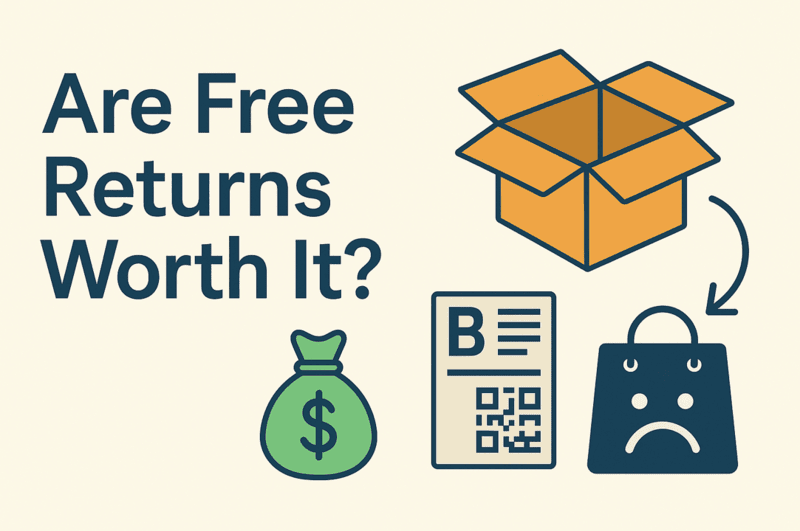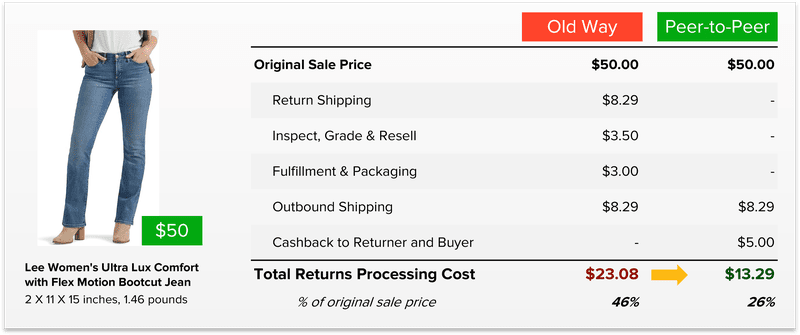Understanding the Cost of Free Returns (Is it Sustainable?)

Last updated on April 24, 2025

In this article
 7 minutes
7 minutes
- Why Free Returns Became the Norm
- The Real Cost of “Free”
- What Happens After the Return?
- The Operational Drag of Reverse Logistics
- Fraud, Abuse, and the Rise of Serial Returners
- Are Free Returns Worth It Anymore?
- What Brands Are Doing Instead
- Smarter Returns Tech for Smarter Sellers
- What Should Online Merchants Do Now?
- Final Thoughts: Rethinking the Value of Free Returns
- Frequently Asked Questions
Free returns have become a staple of modern ecommerce, almost a default expectation. From eBay Sellers and boutique DTC brands to global retail giants, offering free returns is widely viewed as a necessary cost of doing business online. But now, as shipping costs soar and reverse logistics get more complex, a tough question is echoing across boardrooms and Seller forums alike: Are free returns worth it?
If you’re an online merchant trying to balance buyer satisfaction with rising costs, you’re not alone. This article unpacks the financial, operational, and environmental weight of offering free returns, and how smart Sellers are rethinking their returns policy in 2025 and beyond.
Why Free Returns Became the Norm
The free returns revolution started with companies like Zappos, Amazon, and eBay. Their logic was simple: eliminate the friction of buying sight unseen, and you’ll see more sales. They were right; offering free returns increased conversion rates and created a sense of trust. It worked so well that today, over 60% of consumers say they actively check a retailer’s return policy before deciding to make a purchase (Shopify).
For eBay Sellers in particular, offering free returns has often meant better placement in search results, higher trust with buyers, and sometimes even protection from negative feedback. But while the short-term boost in buyer confidence is real, the long-term costs of accepting returns for free are now coming under scrutiny.
The Real Cost of “Free”
Let’s break it down.
When you offer free returns, you’re not just eating the return shipping cost. You’re often paying for:
- Return postage costs (which are climbing faster than outbound rates)
- Processing labor
- Lost packaging and branded inserts
- Refunds issued before resale or inspection
- Product damage in transit or due to missing original packaging
- Customer service hours spent managing the return process
- Inventory write-offs for opened, damaged, or unsellable merchandise
In most cases, that’s a painful hit to your margins, especially for high-value items or products with complex handling requirements.
And while ecommerce return rates average around 20–30%, that number climbs higher in categories like fashion, electronics, and health & beauty—sectors that also tend to offer free shipping and free returns as standard.
What Happens After the Return?
Here’s the kicker: most returned items don’t go back on your shelf. Many are too damaged, outdated, or costly to reprocess. A recent study by the National Retail Federation estimated that returns result in over $816 billion in lost sales per year in the U.S. alone (NRF Report).
Returned goods often end up in liquidation bins, donation centers, or worse—landfills. In fact, returns contribute 5 billion pounds of landfill waste each year in the U.S. alone (BBC). The environmental cost of free returns is massive.
The Operational Drag of Reverse Logistics
Reverse logistics is not just the reverse of order fulfillment—it’s a whole different beast. It’s harder to automate, more error-prone, and costlier at every step.
You need systems that verify proof of return, determine refund eligibility, manage partial refunds for damaged goods, and process reintake efficiently. When those systems aren’t optimized, delays and human error lead to buyer frustration, negative feedback, and lower Seller ratings.
And for small Sellers, especially eBay Sellers managing operations solo, these issues stack up quickly. Handling return requests, checking tracking, issuing a full refund, and updating inventory manually? That’s time you’re not spending selling.
Fraud, Abuse, and the Rise of Serial Returners
Return abuse is another under-reported cost. From buyers wearing clothes once and sending them back, to false claims of a wrong item received, or demanding refunds without proof, serial returners exploit lax return policies. Some cases even involve fraud, like returning different or used products.
In high-volume listings, spotting patterns can be difficult, especially when you’re focused on customer service and speed.
Are Free Returns Worth It Anymore?
Let’s return to our central question.
Are free returns worth it? For some, yes—but only if the benefits outweigh the cost. You might gain competitive advantage and conversion boosts, but the long-term sustainability of your margins, operations, and environmental impact must be considered.
Several factors should guide your decision:
- Product category: Are returns likely (e.g., fashion)? Is resale possible?
- Price point: Do your margins absorb the return hit?
- Customer profile: Do you have frequent serial returners?
- Order value: Do you offer free returns on all purchases or only high-value items?
- Feedback trends: Are your returns helping or hurting your Seller rating?
What Brands Are Doing Instead
Retailers like Zara, Boohoo, and REI have started charging for return shipping, or offering free returns only in-store. Others use returnless refunds for low-cost items where postage costs exceed the product value.
Many brands now reward exchanges over refunds with added benefits, such as bonus discounts or free shipping on replacement items. This preserves revenue while maintaining goodwill.
Others are getting smart with dynamic returns policies—for example, offering more generous terms to loyal customers and stricter ones to high-risk buyers.
Smarter Returns Tech for Smarter Sellers
Tech is a big part of the solution. Tools like:
- Cahoot’s peer-to-peer returns, which reroute return inventory directly to the next buyer, saving cost and time
- True Fit for AI-powered sizing to prevent return-worthy misfits
- Narvar and Loop for post-purchase return management, return portals, and restocking workflows
- Returnalyze for return data analysis and fraud detection
These tools help ecommerce Sellers decide when and how to accept returns while reducing waste and cost.
What Should Online Merchants Do Now?
If you’re an online merchant or ecommerce strategist, here’s your checklist:
- Audit your return data: What are your top reasons for returns? Where are you losing money?
- Segment your policies: Offer free returns only where necessary; use exceptions elsewhere.
- Be transparent: Add return details clearly on store pages and listings to set expectations.
- Offer added benefits for exchanges instead of refunds.
- Track buyer behavior and apply different rules based on return history.
- Invest in tools that reduce guesswork and manual labor, especially for busy eBay Sellers and multichannel brands.
Final Thoughts: Rethinking the Value of Free Returns
So, are free returns worth it? The answer depends on your business model, product mix, and risk tolerance. But one thing is clear: as rising costs, environmental pressures, and operational complexity converge, the traditional one-size-fits-all approach to offering free returns is no longer sustainable.
The next wave of ecommerce growth will come not from generous return perks alone, but from smarter policies, clearer expectations, better tech, and an unwavering focus on long-term value.
Frequently Asked Questions
Are free returns worth it for ecommerce Sellers in 2025?
Free returns can boost conversions and customer trust, but they also come with significant hidden costs. For many Sellers, rising shipping costs, reverse logistics complexity, and return fraud make blanket free returns unsustainable. The decision depends on product margins, return rates, and customer behavior.
What are the biggest hidden costs of offering free returns?
Aside from return shipping and refund payments, Sellers face labor costs, inventory losses, repackaging fees, and increased customer service burdens. High return volumes can also cause warehouse overflow and errors in inventory accuracy, especially without optimized returns processes.
How do free returns impact the environment?
Returned items often travel long distances, contributing to increased carbon emissions. Many returns end up in landfills due to damage or resale complexity, resulting in millions of pounds of waste. The environmental toll of two-way shipping and packaging materials makes free returns a major sustainability challenge.
What alternatives to free returns are online merchants using?
Retailers are implementing several smarter approaches: charging return shipping fees, encouraging exchanges over refunds, offering returnless refunds for low-value items, and using tech to reduce preventable returns. Some brands tailor return policies based on customer history or product type.
How can Sellers reduce return rates without hurting sales?
Investing in better product content, sizing tools, and post-purchase education can reduce buyer’s remorse and return volume. Offering partial refunds or incentives for exchanges also helps preserve revenue. Smart returns software and dynamic policies help Sellers offer flexibility without sacrificing profitability.

Up to 64% Lower Returns Processing Cost


